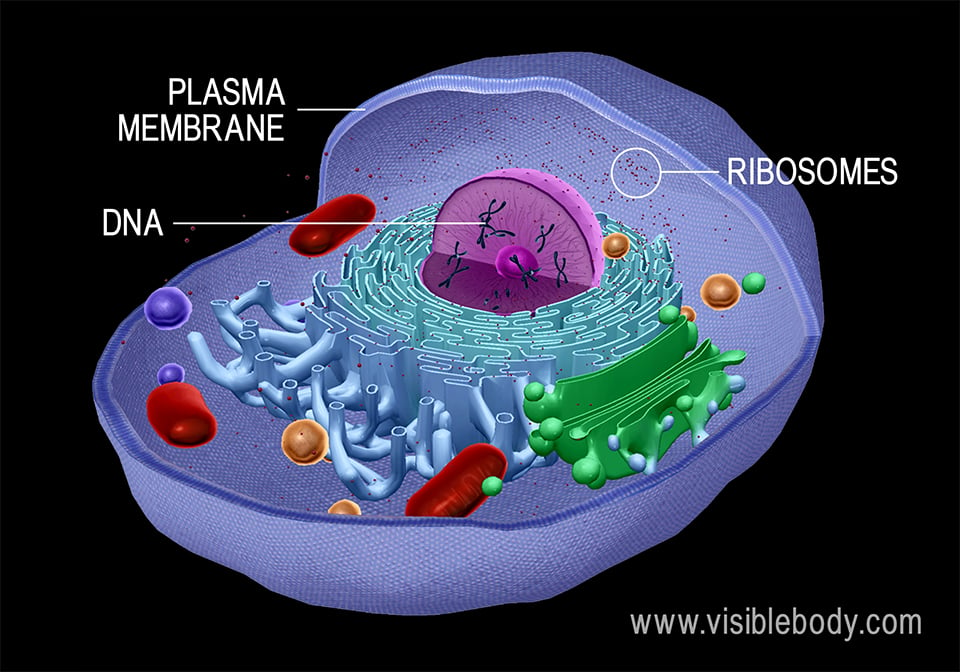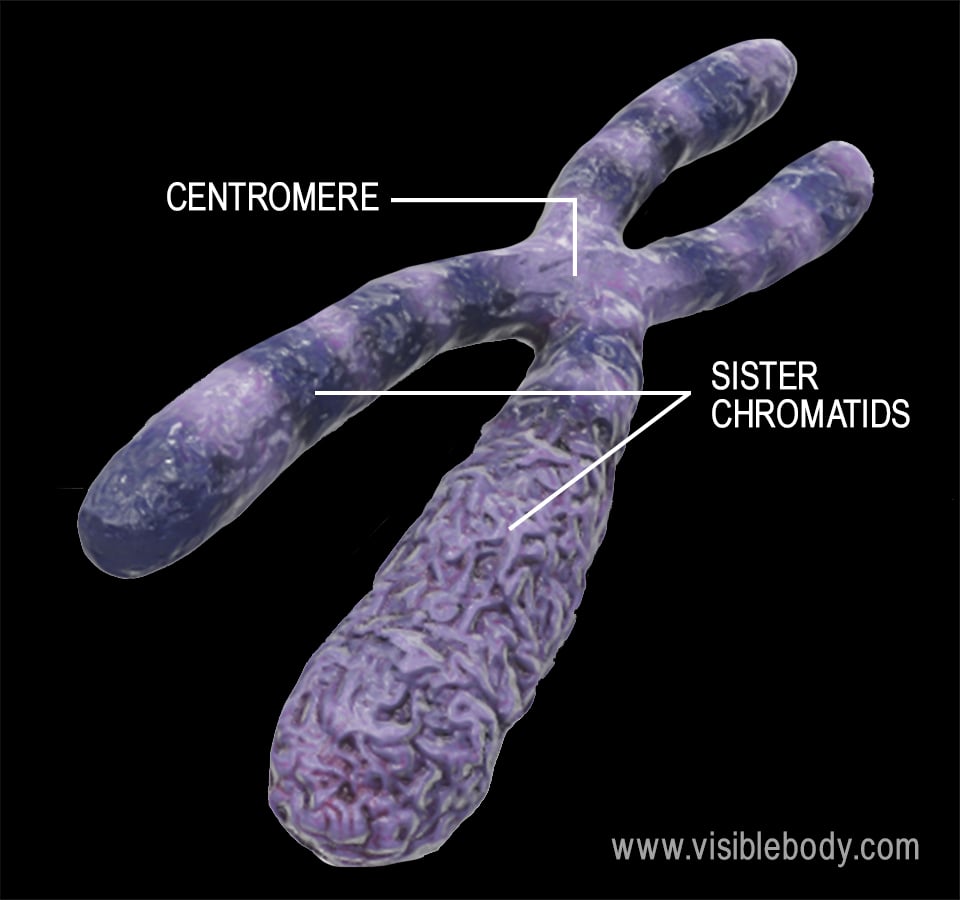The 3D models on this website are completely interactive! If you're using a supported mobile device, you can view them in augmented reality.

Prokaryotic cells comprise bacteria and archaea. They typically have a diameter of 0.1–5 μm, and their DNA is not contained within a nucleus. Instead, their DNA is circular and can be found in a region called the nucleoid, which floats in the cytoplasm.

DNA is one of the most important molecules in all of biology. From the simplest bacteria to the multicellular tissues and organs of the human body, DNA provides each living cell with instructions to make the proteins it needs to carry out its functions. DNA is essential to life as we know it, replicating itself and passing its genetic information from parent to offspring.
The principal feature that distinguishes a eukaryotic cell from a prokaryotic cell is the presence of a membrane-bound nucleus. This nucleus is the “control center” of the cell that stores all the cell’s genetic information, or DNA. The nuclear membrane, or nuclear envelope, contains channels called pores that regulate the movement of molecules in and out of the nucleus.
Unlike eukaryotic cells, prokaryotic cells don’t have a membrane-bound nucleus. Instead, their genetic material can be found in a region of the cytoplasm called the nucleoid. A prokaryotic cell typically has only a single, coiled, circular chromosome. However, there are a few prokaryotes that have more than one—Vibrio cholerae, the bacterium that causes cholera, has two circular chromosomes.
Since prokaryotic cells typically have only a single, circular chromosome, they can replicate faster than eukaryotic cells. In fact, a prokaryotic cell can undergo two rounds of DNA replication before the cell, itself, has divided. This means that DNA replication can occur during cell division in prokaryotes.
DNA is a macromolecule consisting of two strands that twist around a common axis in a shape called a double helix. The double helix looks like a twisted ladder—the rungs of the ladder are composed of pairs of nitrogenous bases (base pairs), and the sides of the ladder are made up of alternating sugar molecules and phosphate groups.
Molecules of DNA range in length from hundreds of thousands to millions of base pairs. The smallest chromosome in the human genome, Chromosome 21, has around 48 million base pairs.

Blood is fluid connective tissue that circulates throughout the body. Why is it considered to be fluid connective tissue instead of just a fluid? It is composed of living cells suspended in plasma, the liquid that makes up around 55% of the blood. Plasma transports blood cells, proteins, electrolytes, hormones, and nutrients throughout the body. It also brings waste products from the body tissues to the urinary system, where the kidneys filter them out of the blood.
Hemocytoblasts, or multipotent hematopoietic stem cells, give rise tomyeloid stem cells, which differentiate into myeloblasts, megakaryocytes, andred blood cells (erythrocytes). Red blood cell production is regulated by the hormoneerythropoietin, which is produced by cells in the kidneys and liver.
Mature red blood cells are flexible, oval or round biconcave discs that move easily through the blood vessels. Certain pathologies, such as sickle-cell anemia, alter the shape and flexibility of red blood cells, making it difficult for them to move smoothly through blood vessels.
White blood cells (leukocytes) differ from red blood cells in several key ways. They are larger and less numerous than red blood cells. In addition, they have nuclei and organelles, whereas red blood cells and platelets do not.
Red blood cells are constantly circulating throughout the body, carrying oxygen from the lungs to the body’s tissues. In contrast, white blood cells aren’t always on the move. Most leukocytes spend a short time circulating in the blood, and the rest of the time, they can be found within lymphatic tissues or organs like the thymus or spleen. When infection or inflammation occurs, white blood cells move where they’re needed.
Between 2 and 10% of all white blood cells (leukocytes) in the body are monocytes, or agranular myeloid white blood cells. Monocytes are the largest type of leukocytes.
Monocytes are classified as agranular because they do not have visible granules when examined through a microscope. Their nuclei are kidney shaped, and since they are not lobed, monocytes are often referred to as mononuclear leukocytes. When a hematoxylin and eosin (H&E) histological stain is used, the nucleus appears dark purple, and the surrounding cytoplasm is light blue. Although the cytoplasm doesn’t contain visible granules, it does have lysosomes—organelles containing enzymes that can break down biological material, from waste within the cell to viruses and bacteria that they engulf.
Lymphocytes are the second most common type of white blood cell (leukocyte), making up between 15 and 40% of circulating white blood cells in peripheral blood. They briefly circulate in the blood, but most of the time, they can be found moving through lymphatic tissue.
Lymphocytes are also known as mononuclear leukocytes because they have large, spherical nuclei that are not lobed. When a hematoxylin and eosin (H&E) histological stain is used, the nucleus appears dark purple, surrounded by a thin layer of pale blue cytoplasm.

Like all living things, plants need energy to carry out the processes that keep them alive. They get this energy from food. Humans and most other animals are heterotrophs, meaning we have to consume other organisms—plants, other animals, or some combination of the two—for food. However, plants are autotrophs, meaning they create their own food.
When it comes to photosynthesis, the most important parts of the plant are the leaves. Their cells and structures are specialized to take in light and allow for gas exchange with the air around them. They also contain vascular structures that transport water from the roots into the cells that carry out photosynthesis.
Within plant cells, chloroplasts are specialized organelles that serve as the sites of photosynthesis. The reactions that make up the process of photosynthesis can be divided into light-dependent reactions, which take place in the thylakoids, and light-independent reactions (also known as dark reactions or the Calvin cycle), which take place in the stroma.

Life on our planet began with single-celled organisms and now encompasses everything from bacteria to fungi to plants and animals—about 8.7 million different species of living organisms. And that’s just the species alive today! Over the course of Earth’s history, there have been around 4 billion different species, most of which have gone extinct. Earth has changed, too—from the composition of its atmosphere (thanks for the oxygen, ancient cyanobacteria!), to the position of continents, to the climate.
Evolution is the process by which populations change over time. When we talk about how populations change in an evolutionary sense, we’re generally talking about the frequency of different alleles within that population. Remember: an allele is one “version” of a particular gene. Different alleles are often associated with different phenotypes, or observable traits, such as seed color in pea plants or beak size in finches.
In sexually reproducing organisms, a species is a group of organisms that can successfully interbreed and produce fertile offspring. New species develop all the time…but how? In evolutionary biology, speciation is defined as the formation of one or more new descendant species from one ancestor species.
When you select "Subscribe" you will start receiving our email newsletter. Use the links at the bottom of any email to manage the type of emails you receive or to unsubscribe. See our privacy policy for additional details.